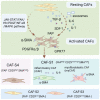The Role of Cancer-Associated Fibroblasts in Ovarian Cancer
- PMID: 35681617
- PMCID: PMC9179444
- DOI: 10.3390/cancers14112637
The Role of Cancer-Associated Fibroblasts in Ovarian Cancer
Abstract
Ovarian cancer is a lethal gynecologic tumor and is generally resistant to conventional treatments. Stable cancer-associated fibroblasts (CAFs) are important cellular components in the ovarian cancer tumor microenvironment and may provide novel resources for future treatment strategies. Different subtypes of CAFs display specific functions in tumor pathogenesis and various CAF markers suggest potential treatment targets, such as FAP and GPR77. Both autocrine and paracrine cytokines play important roles in the CAF activation process and regulate tumor progression. Downstream mediators and pathways, including IL-6, TGF-β, NF-κB, mitogen-activated protein kinase (MAPK), and AKT/mTOR/(p70S6K), play important roles in the initiation, proliferation, invasiveness, and metastasis of ovarian cancer cells and also participate in angiogenesis, therapeutic resistance, and other biological processes. Several clinical or preclinical trials have targeted stromal fibroblasts and focused on the properties of CAFs to enhance ovarian cancer treatment outcomes. This review concentrates on the origins, subtypes, and activation of CAFs, as well as specific roles of CAFs in regulating tumor development and drug resistance, and aims to provide potential and prospective targets for improving the therapeutic efficacy of ovarian cancer treatment.
Keywords: cancer-associated fibroblasts; ovarian cancer; stroma; tumor microenvironment.
Conflict of interest statement
The authors declare no conflict of interest.
Figures




Similar articles
-
Regulation of heterogeneous cancer-associated fibroblasts: the molecular pathology of activated signaling pathways.J Exp Clin Cancer Res. 2020 Jun 16;39(1):112. doi: 10.1186/s13046-020-01611-0. J Exp Clin Cancer Res. 2020. PMID: 32546182 Free PMC article. Review.
-
The role of stromal cancer-associated fibroblasts in pancreatic cancer.J Hematol Oncol. 2017 Mar 28;10(1):76. doi: 10.1186/s13045-017-0448-5. J Hematol Oncol. 2017. PMID: 28351381 Free PMC article. Review.
-
Signaling pathways in cancer-associated fibroblasts: recent advances and future perspectives.Cancer Commun (Lond). 2023 Jan;43(1):3-41. doi: 10.1002/cac2.12392. Epub 2022 Nov 24. Cancer Commun (Lond). 2023. PMID: 36424360 Free PMC article. Review.
-
Architecture of Cancer-Associated Fibroblasts in Tumor Microenvironment: Mapping Their Origins, Heterogeneity, and Role in Cancer Therapy Resistance.OMICS. 2020 Jun;24(6):314-339. doi: 10.1089/omi.2020.0023. OMICS. 2020. PMID: 32496970
-
FAPhigh α-SMAlow cancer-associated fibroblast-derived SLPI protein encapsulated in extracellular vesicles promotes ovarian cancer development via activation of PI3K/AKT and downstream signaling pathways.Mol Carcinog. 2022 Oct;61(10):910-923. doi: 10.1002/mc.23445. Epub 2022 Jul 8. Mol Carcinog. 2022. PMID: 35801406 Free PMC article.
Cited by
-
Integration of local and systemic immunity in ovarian cancer: Implications for immunotherapy.Front Immunol. 2022 Nov 10;13:1018256. doi: 10.3389/fimmu.2022.1018256. eCollection 2022. Front Immunol. 2022. PMID: 36439144 Free PMC article. Review.
-
Comprehensive single-cell analysis reveals heterogeneity of fibroblast subpopulations in ovarian cancer tissue microenvironment.Heliyon. 2024 Mar 19;10(6):e27873. doi: 10.1016/j.heliyon.2024.e27873. eCollection 2024 Mar 30. Heliyon. 2024. PMID: 38533040 Free PMC article.
-
A patient stratification signature mirrors the immunogenic potential of high grade serous ovarian cancers.J Transl Med. 2024 Nov 20;22(1):1048. doi: 10.1186/s12967-024-05846-9. J Transl Med. 2024. PMID: 39568014 Free PMC article.
-
Cancer-associated fibroblast-secreted FGF7 as an ovarian cancer progression promoter.J Transl Med. 2024 Mar 15;22(1):280. doi: 10.1186/s12967-024-05085-y. J Transl Med. 2024. PMID: 38491511 Free PMC article.
-
Extracellular Vesicles in Ovarian Cancer: From Chemoresistance Mediators to Therapeutic Vectors.Biomedicines. 2024 Aug 9;12(8):1806. doi: 10.3390/biomedicines12081806. Biomedicines. 2024. PMID: 39200270 Free PMC article. Review.
References
-
- Colombo N., Sessa C., du Bois A., Ledermann J., McCluggage W.G., McNeish I., Morice P., Pignata S., Ray-Coquard I., Vergote I., et al. ESMO-ESGO consensus conference recommendations on ovarian cancer: Pathology and molecular biology, early and advanced stages, borderline tumours and recurrent disease. Ann. Oncol. 2019;30:672–705. doi: 10.1093/annonc/mdz062. - DOI - PubMed
-
- Piver M.S. Treatment of ovarian cancer at the crossroads: 50 years after single-agent melphalan chemotherapy. Oncology. 2006;20:1156–1158. - PubMed
Publication types
Grants and funding
LinkOut - more resources
Full Text Sources
Miscellaneous

